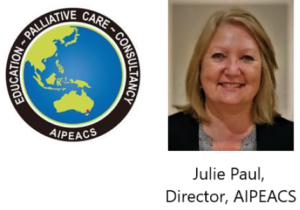
日本語訳 監修 木下佳代子 ジェックス参与
-
今月は、「緩和ケアとは何か」「何が緩和ケアではないのか」を議論する際のコミュニケーションの重要性について考えてみたいと思います。
-
緩和ケアと終末期医療の違いを地域社会に伝えるには、言葉の一貫性が最も重要です。
あなたの組織や病棟には緩和ケアに関するポリシーがありますか?
-
方針があれば。
– 緩和ケアと終末期ケアは区別されているか。
– その方針は、がんだけでなく、他の慢性疾患も含める広範囲なものであるか。
– 緩和ケアと終末期医療という言葉について、多職種が共通の認識を持っているか。
– 緩和ケアや終末期医療に関するメッセージが一貫性をもって患者とのコミュニケーションに使われているか。
– 緩和ケアの理念と実践について、多分野にまたがるチーム全体に対する専門的な能力開発が行われているか。
– 患者のケアプランに、患者が死亡する前に終末期医療を受けることが反映されているか。 つまり、患者が人生の最後の数日間または数週間にいる場所をピックアップしているか?
– 予想される死亡について、病棟レベルでデスレビューが行われているか。 私たちは何がうまくできたのか? もっと良くできることは? この会議で合意されたフォローアップのための
-
適切な行動計画や時間枠があるか
-
これらの質問を振り返った上で、あなたの組織/病棟では、緩和ケアのメッセージがうまく行われているかどうかを判断してください。 どのようにしたらこれを推進できるか、
-
また、あなたの所属する組織や病棟での実践を改善するために、どのような支援や手段を利用できるか、自問してみてください。
緩和ケアにまつわる誤った考えについて話すことに抵抗がなければ、メッセージの一貫性に役立ち、チーム にとって貴重な教育セッションとなります。
以下は参考になる資料です。
ご参考までに、いくつかの資料をご紹介します。
– 緩和ケアに関する10の間違った考え カナダのバーチャルホスピスが日本語に翻訳したインフォグラフィック(グラフや図表を視覚的に表したもの)です。
– 切除不能や、再発を繰り返す癌患者における緩和ケアと健康状態に関するコミュニケーションに対する日本人患者の理解度:クロスセクション調査。 (Vol 10, No 3 2021年3月), 平塚由美子, 大石哲也, 宮下正樹, 森田隆, J Mack, 高橋正, 城田浩, 大塚和彦, 石岡千恵, 井上明)
https://pubmed.ncbi.nlm.nih.gov/33549021/ ( 全文へのリンクはページ右上をご参照ください )
– 多職種チームによる心不全の緩和ケアと終末期の食事摂取、2021年7月、柴田哲也、馬渡和也、中島直樹、下薗紘一、牛島和彦、山地康弘、手塚健、村上真、岡場健、箭内哲也、野原誠、高橋治、青木裕、安川浩、福本康夫 https://doi.org/10.3390/nu13072387
– 多職種チームによる心不全の緩和ケアと終末期の食事摂取、2021年7月、柴田哲也、馬渡和也、中島直樹、下薗紘一、牛島和彦、山地康弘、手塚健、村上真、岡場健、箭内哲也、野原誠、高橋治、青木裕、安川浩、福本康夫 https://doi.org/10.3390/nu13072387
もし、追加情報が必要な分野があれば、julie@palliativeeducation.com までリクエスト(英語または日本語)していただければ、確実に検討させていただきます。
緩和ケアに関する皆さんの考えや経験を共有し、お互いに学び続けることができればと思いますので、皆さんの様子を教えてください。
来月のキャッチアップを楽しみにしています。 お元気で!
ジュリーより
[事務局より]
ジュリーさんは、皆様からの感想、質問などをお待ちしています。
-
Disclaimer: March 2022 免責条項:
Australian International Palliative Education and Consultancy Services (AIPEACS) は、Julie’s Corner シリーズ内の内容につき正確な情報の提供に細心の注意を注いでいますが、特にある事柄についての専門的意見を提供するものではありません。このシリーズに含まれる情報は、独立した専門家の見解に取って代るものではありません。また、医療上の助言として利用したり、何らかの疾患の治療、手当、又は、予防のために使用されるものではありません。
AIPEACSは、このシリーズにより提供される情報の利用、依存によるいかなる法的責任、怪我、紛失、損害については、責任は負いません 。
Australian International Palliative Education and Consultancy Services Pty. Ltd -
Julie’s Update: March 2022 (原文)
This month let’s reflect on the importance of our communication when discussing what palliative care is and isn’t. Consistency in language is paramount if we are to communicate to our community the difference between palliative care and end of life/ terminal care.
It is interesting to consider, Does your organisation/ward have a palliative care policy?
If there is a policy:
- Is there a distinction between palliative care and end of life care/ terminal care?
- Is the policy broad enough to include cancer as well as other chronic conditions?
- Do all of the multidisciplinary team have a shared understanding of the words palliative care and end of life/ terminal care?
- Do we see communication within the workplace with patients that reflects consistency in messaging about palliative care and end of life/ terminal care, across the interdisciplinary team?
- Is there professional development for the whole interdisciplinary team around palliative care philosophy and practices?
- Do patients care plans reflect that they are end of life/terminal care prior to their death. That is, are we picking up where patients are in the last few days or weeks of life?
- Are there death reviews held at the ward level for expected deaths. What did we do well? What can we do better? Are there appropriate action plans and time frames for any agreed follow ups from this meeting.
Upon reflecting on these questions, determine if your organisation/ ward provides palliative care messaging well. Ask yourself, how can you promote this, or what support/ avenues can you access to making any changes which may improve practice in the organisation/ward you work on?
Being comfortable talking about the myths of palliative care, will also assist in the consistency in messaging and is a valuable education session for the team.
Here are some resources you may find helpful:
- – 10 Myths about Palliative Care Infographic translated into Japanese from the Canadian Virtual Hospice
- – Patients’ understanding of communication about palliative care and health condition in Japanese patients with unresectable or recurrent cancer: a cross section survey. (Vol 10, No 3 March 2021), Y Hiratsuka, T Oishi, M Miyashita, T Morita, J Mack, M Takahashi, H Shirota, K Otsuka, C Ishioka, A Inoue https://pubmed.ncbi.nlm.nih.gov/33549021/ ( refer to top right hand of page for link to full text)
- – Multidisciplinary Team Based Palliative Care for Heart Failure and Food Intake at End of Life, July 2021, T Shibata, K Mawatari, N Nakashima, K Shimozono, K Ushijima, Y Yamaji, K Tetsuka, M Murakami, K Okaba,
- T Yanai, S Nohara, J Takahashi, H Aoki, H Yasukawa, Y Fukumoto
- https://doi.org/10.3390/nu13072387
If you have any particular areas you would like additional information on, please forward your request (either in English or Japanese) to julie@palliativeeducation.com and we will ensure this is discussed.
Please let me know how you are going as we would enjoy sharing your thoughts and experiences on palliative care, so that we can continue to learn from each other.
I am looking forward to our next month’s catch up.
Take care Julie
